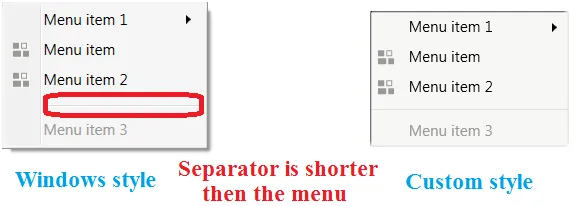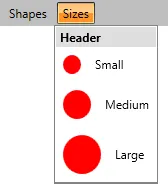我认为这就是你想要的(再次使用Expression Blend解决了它,但在显示方面,它是最简单的...并且需要大量尝试调整)...你可以将以下内容作为示例放入空白的WPF应用程序中:
<Window x:Class="MenuItemWithNoIcon.MainWindow"
xmlns="http:
xmlns:x="http:
Title="MainWindow" Height="350" Width="525">
<Window.Resources>
<SolidColorBrush x:Key="MenuItem.Highlight.Background" Color="#3D26A0DA"/>
<SolidColorBrush x:Key="MenuItem.Highlight.Border" Color="#FF26A0DA"/>
<SolidColorBrush x:Key="Menu.Disabled.Foreground" Color="#FF707070"/>
<SolidColorBrush x:Key="MenuItem.Highlight.Disabled.Background" Color="#0A000000"/>
<SolidColorBrush x:Key="MenuItem.Highlight.Disabled.Border" Color="#21000000"/>
<SolidColorBrush x:Key="MenuItem.Selected.Border" Color="#FF26A0DA"/>
<SolidColorBrush x:Key="MenuItem.Selected.Background" Color="#3D26A0DA"/>
<Geometry x:Key="Checkmark">F1 M 10.0,1.2 L 4.7,9.1 L 4.5,9.1 L 0,5.2 L 1.3,3.5 L 4.3,6.1L 8.3,0 L 10.0,1.2 Z</Geometry>
<SolidColorBrush x:Key="Menu.Static.Foreground" Color="#FF212121"/>
<ControlTemplate x:Key="}" TargetType="">
<Border x:Name="templateRoot" BorderBrush="" BorderThickness="" Background="" Height="22" SnapsToDevicePixels="true">
<Grid Margin="0">
<Grid.ColumnDefinitions>
<ColumnDefinition Width="*"/>
</Grid.ColumnDefinitions>
<ContentPresenter x:Name="menuHeaderContainer" ContentSource="Header" HorizontalAlignment="Stretch" Margin="" RecognizesAccessKey="True" SnapsToDevicePixels="" VerticalAlignment="Stretch"/>
</Grid>
</Border>
<ControlTemplate.Triggers>
<Trigger Property="Icon" Value=""/>
<Trigger Property="IsChecked" Value="True"/>
<Trigger Property="IsHighlighted" Value="True">
<Setter Property="Background" TargetName="templateRoot" Value=""/>
<Setter Property="BorderBrush" TargetName="templateRoot" Value=""/>
</Trigger>
<Trigger Property="IsEnabled" Value="False">
<Setter Property="TextElement.Foreground" TargetName="templateRoot" Value=""/>
</Trigger>
<MultiTrigger>
<MultiTrigger.Conditions>
<Condition Property="IsHighlighted" Value="True"/>
<Condition Property="IsEnabled" Value="False"/>
</MultiTrigger.Conditions>
<Setter Property="Background" TargetName="templateRoot" Value=""/>
<Setter Property="BorderBrush" TargetName="templateRoot" Value=""/>
</MultiTrigger>
</ControlTemplate.Triggers>
</ControlTemplate>
<SolidColorBrush x:Key="Menu.Static.Border" Color="#FF999999"/>
<SolidColorBrush x:Key="Menu.Static.Background" Color="#FFF0F0F0"/>
<SolidColorBrush x:Key="Menu.Static.Separator" Color="#FFD7D7D7"/>
<Geometry x:Key="UpArrow">M 0,4 L 3.5,0 L 7,4 Z</Geometry>
<Style x:Key="MenuScrollButton" BasedOn="" TargetType="">
<Setter Property="ClickMode" Value="Hover"/>
<Setter Property="Template">
<Setter.Value>
<ControlTemplate TargetType="">
<Border x:Name="templateRoot" BorderBrush="Transparent" BorderThickness="1" Background="Transparent" SnapsToDevicePixels="true">
<ContentPresenter HorizontalAlignment="Center" Margin="6" VerticalAlignment="Center"/>
</Border>
</ControlTemplate>
</Setter.Value>
</Setter>
</Style>
<MenuScrollingVisibilityConverter x:Key="MenuScrollingVisibilityConverter"/>
<Geometry x:Key="DownArrow">M 0,0 L 3.5,4 L 7,0 Z</Geometry>
<Style x:Key="}" BasedOn="" TargetType="">
<Setter Property="HorizontalScrollBarVisibility" Value="Hidden"/>
<Setter Property="VerticalScrollBarVisibility" Value="Auto"/>
<Setter Property="Template">
<Setter.Value>
<ControlTemplate TargetType="">
<Grid SnapsToDevicePixels="true">
<Grid.ColumnDefinitions>
<ColumnDefinition Width="*"/>
</Grid.ColumnDefinitions>
<Grid.RowDefinitions>
<RowDefinition Height="Auto"/>
<RowDefinition Height="*"/>
<RowDefinition Height="Auto"/>
</Grid.RowDefinitions>
<Border Grid.Column="0" Grid.Row="1">
<ScrollContentPresenter CanContentScroll="" Margin=""/>
</Border>
<RepeatButton Grid.Column="0" CommandTarget="}" Command="" Focusable="false" Grid.Row="0" Style="">
<RepeatButton.Visibility>
<MultiBinding ConverterParameter="0" Converter="" FallbackValue="Visibility.Collapsed">
<Binding Path="ComputedVerticalScrollBarVisibility" RelativeSource=""/>
<Binding Path="VerticalOffset" RelativeSource=""/>
<Binding Path="ExtentHeight" RelativeSource=""/>
<Binding Path="ViewportHeight" RelativeSource=""/>
</MultiBinding>
</RepeatButton.Visibility>
<Path Data="" Fill=""/>
</RepeatButton>
<RepeatButton Grid.Column="0" CommandTarget="}" Command="" Focusable="false" Grid.Row="2" Style="">
<RepeatButton.Visibility>
<MultiBinding ConverterParameter="100" Converter="" FallbackValue="Visibility.Collapsed">
<Binding Path="ComputedVerticalScrollBarVisibility" RelativeSource=""/>
<Binding Path="VerticalOffset" RelativeSource=""/>
<Binding Path="ExtentHeight" RelativeSource=""/>
<Binding Path="ViewportHeight" RelativeSource=""/>
</MultiBinding>
</RepeatButton.Visibility>
<Path Data="" Fill=""/>
</RepeatButton>
</Grid>
</ControlTemplate>
</Setter.Value>
</Setter>
</Style>
<ControlTemplate x:Key="}" TargetType="">
<Border x:Name="templateRoot" BorderBrush="" BorderThickness="" Background="" SnapsToDevicePixels="true">
<Grid VerticalAlignment="Center">
<Grid.ColumnDefinitions>
<ColumnDefinition Width="Auto"/>
<ColumnDefinition Width="Auto"/>
</Grid.ColumnDefinitions>
<Path x:Name="GlyphPanel" Data="" Fill="" FlowDirection="LeftToRight" Margin="3" Visibility="Collapsed" VerticalAlignment="Center"/>
<ContentPresenter Grid.Column="1" ContentSource="Header" Margin="" RecognizesAccessKey="True" SnapsToDevicePixels=""/>
<Popup x:Name="PART_Popup" AllowsTransparency="true" Focusable="false" IsOpen="}" PopupAnimation="}" Placement="Bottom" PlacementTarget="">
<Border x:Name="SubMenuBorder" BorderBrush="" BorderThickness="1" Background="" Padding="0">
<ScrollViewer x:Name="SubMenuScrollViewer" Style="}}">
<Grid RenderOptions.ClearTypeHint="Enabled">
<Canvas HorizontalAlignment="Left" Height="0" VerticalAlignment="Top" Width="0">
<Rectangle x:Name="OpaqueRect" Fill="" Height="" Width=""/>
</Canvas>
<Rectangle Fill="" HorizontalAlignment="Left" Margin="0" Width="1"/>
<ItemsPresenter x:Name="ItemsPresenter" KeyboardNavigation.DirectionalNavigation="Cycle" Grid.IsSharedSizeScope="true" SnapsToDevicePixels="" KeyboardNavigation.TabNavigation="Cycle"/>
</Grid>
</ScrollViewer>
</Border>
</Popup>
</Grid>
</Border>
<ControlTemplate.Triggers>
<Trigger Property="IsSuspendingPopupAnimation" Value="true">
<Setter Property="PopupAnimation" TargetName="PART_Popup" Value="None"/>
</Trigger>
<Trigger Property="Icon" Value=""/>
<Trigger Property="IsChecked" Value="true">
<Setter Property="Visibility" TargetName="GlyphPanel" Value="Visible"/>
</Trigger>
<Trigger Property="IsHighlighted" Value="True">
<Setter Property="Background" TargetName="templateRoot" Value=""/>
<Setter Property="BorderBrush" TargetName="templateRoot" Value=""/>
</Trigger>
<Trigger Property="IsEnabled" Value="False">
<Setter Property="TextElement.Foreground" TargetName="templateRoot" Value=""/>
<Setter Property="Fill" TargetName="GlyphPanel" Value=""/>
</Trigger>
<Trigger Property="ScrollViewer.CanContentScroll" SourceName="SubMenuScrollViewer" Value="false">
<Setter Property="Canvas.Top" TargetName="OpaqueRect" Value=""/>
<Setter Property="Canvas.Left" TargetName="OpaqueRect" Value=""/>
</Trigger>
</ControlTemplate.Triggers>
</ControlTemplate>
<ControlTemplate x:Key="}" TargetType="">
<Border x:Name="templateRoot" BorderBrush="" BorderThickness="" Background="" SnapsToDevicePixels="true">
<Grid VerticalAlignment="Center">
<Grid.ColumnDefinitions>
<ColumnDefinition Width="Auto"/>
<ColumnDefinition Width="Auto"/>
</Grid.ColumnDefinitions>
<ContentPresenter x:Name="Icon" ContentSource="Icon" HorizontalAlignment="Center" Height="16" Margin="3" SnapsToDevicePixels="" VerticalAlignment="Center" Width="16"/>
<Path x:Name="GlyphPanel" Data="" Fill="" FlowDirection="LeftToRight" Margin="3" Visibility="Collapsed" VerticalAlignment="Center"/>
<ContentPresenter Grid.Column="1" ContentSource="Header" Margin="" RecognizesAccessKey="True" SnapsToDevicePixels=""/>
</Grid>
</Border>
<ControlTemplate.Triggers>
<Trigger Property="Icon" Value="">
<Setter Property="Visibility" TargetName="Icon" Value="Collapsed"/>
</Trigger>
<Trigger Property="IsChecked" Value="true">
<Setter Property="Visibility" TargetName="GlyphPanel" Value="Visible"/>
<Setter Property="Visibility" TargetName="Icon" Value="Collapsed"/>
</Trigger>
<Trigger Property="IsHighlighted" Value="True">
<Setter Property="Background" TargetName="templateRoot" Value=""/>
<Setter Property="BorderBrush" TargetName="templateRoot" Value=""/>
</Trigger>
<Trigger Property="IsEnabled" Value="False">
<Setter Property="TextElement.Foreground" TargetName="templateRoot" Value=""/>
<Setter Property="Fill" TargetName="GlyphPanel" Value=""/>
</Trigger>
<MultiTrigger>
<MultiTrigger.Conditions>
<Condition Property="IsHighlighted" Value="True"/>
<Condition Property="IsEnabled" Value="False"/>
</MultiTrigger.Conditions>
<Setter Property="Background" TargetName="templateRoot" Value=""/>
<Setter Property="BorderBrush" TargetName="templateRoot" Value=""/>
</MultiTrigger>
</ControlTemplate.Triggers>
</ControlTemplate>
<Geometry x:Key="RightArrow">M 0,0 L 4,3.5 L 0,7 Z</Geometry>
<ControlTemplate x:Key="}" TargetType="">
<Border x:Name="templateRoot" BorderBrush="" BorderThickness="" Background="" Height="22" SnapsToDevicePixels="true">
<Grid Margin="-1">
<Grid.ColumnDefinitions>
<ColumnDefinition MinWidth="22" SharedSizeGroup="MenuItemIconColumnGroup" Width="Auto"/>
<ColumnDefinition Width="13"/>
<ColumnDefinition Width="*"/>
<ColumnDefinition Width="30"/>
<ColumnDefinition SharedSizeGroup="MenuItemIGTColumnGroup" Width="Auto"/>
<ColumnDefinition Width="20"/>
</Grid.ColumnDefinitions>
<ContentPresenter x:Name="Icon" ContentSource="Icon" HorizontalAlignment="Center" Height="16" Margin="3" SnapsToDevicePixels="" VerticalAlignment="Center" Width="16"/>
<Border x:Name="GlyphPanel" BorderBrush="" BorderThickness="1" Background="" Height="22" Margin="-1,0,0,0" Visibility="Hidden" VerticalAlignment="Center" Width="22">
<Path x:Name="Glyph" Data="" Fill="" FlowDirection="LeftToRight" Height="11" Width="9"/>
</Border>
<ContentPresenter Grid.Column="2" ContentSource="Header" HorizontalAlignment="Left" Margin="" RecognizesAccessKey="True" SnapsToDevicePixels="" VerticalAlignment="Center"/>
<TextBlock Grid.Column="4" Margin="" Opacity="0.7" Text="" VerticalAlignment="Center"/>
<Path x:Name="RightArrow" Grid.Column="5" Data="" Fill="" HorizontalAlignment="Left" Margin="10,0,0,0" VerticalAlignment="Center"/>
<Popup x:Name="PART_Popup" AllowsTransparency="true" Focusable="false" HorizontalOffset="-2" IsOpen="}" PopupAnimation="}" Placement="Right" VerticalOffset="-3">
<Border x:Name="SubMenuBorder" BorderBrush="" BorderThickness="1" Background="" Padding="2">
<ScrollViewer x:Name="SubMenuScrollViewer" Style="}}">
<Grid RenderOptions.ClearTypeHint="Enabled">
<Canvas HorizontalAlignment="Left" Height="0" VerticalAlignment="Top" Width="0">
<Rectangle x:Name="OpaqueRect" Fill="" Height="" Width=""/>
</Canvas>
<Rectangle Fill="}" HorizontalAlignment="Left" Margin="29,2,0,2" Width="1"/>
<ItemsPresenter x:Name="ItemsPresenter" KeyboardNavigation.DirectionalNavigation="Cycle" Grid.IsSharedSizeScope="true" SnapsToDevicePixels="" KeyboardNavigation.TabNavigation="Cycle"/>
</Grid>
</ScrollViewer>
</Border>
</Popup>
</Grid>
</Border>
<ControlTemplate.Triggers>
<Trigger Property="IsSuspendingPopupAnimation" Value="true">
<Setter Property="PopupAnimation" TargetName="PART_Popup" Value="None"/>
</Trigger>
<Trigger Property="Icon" Value="">
<Setter Property="Visibility" TargetName="Icon" Value="Collapsed"/>
</Trigger>
<Trigger Property="IsChecked" Value="True">
<Setter Property="Visibility" TargetName="GlyphPanel" Value="Visible"/>
<Setter Property="Visibility" TargetName="Icon" Value="Collapsed"/>
</Trigger>
<Trigger Property="IsHighlighted" Value="True">
<Setter Property="Background" TargetName="templateRoot" Value="Transparent"/>
<Setter Property="BorderBrush" TargetName="templateRoot" Value=""/>
</Trigger>
<Trigger Property="IsEnabled" Value="False">
<Setter Property="TextElement.Foreground" TargetName="templateRoot" Value=""/>
<Setter Property="Fill" TargetName="Glyph" Value=""/>
<Setter Property="Fill" TargetName="RightArrow" Value=""/>
</Trigger>
<Trigger Property="ScrollViewer.CanContentScroll" SourceName="SubMenuScrollViewer" Value="false">
<Setter Property="Canvas.Top" TargetName="OpaqueRect" Value=""/>
<Setter Property="Canvas.Left" TargetName="OpaqueRect" Value=""/>
</Trigger>
</ControlTemplate.Triggers>
</ControlTemplate>
<Style x:Key="MenuItemStyle1" TargetType="">
<Setter Property="HorizontalContentAlignment" Value="}}"/>
<Setter Property="VerticalContentAlignment" Value="}}"/>
<Setter Property="Background" Value="Transparent"/>
<Setter Property="BorderBrush" Value="Transparent"/>
<Setter Property="BorderThickness" Value="1"/>
<Setter Property="ScrollViewer.PanningMode" Value="Both"/>
<Setter Property="Stylus.IsFlicksEnabled" Value="False"/>
<Setter Property="Template" Value="}}"/>
<Style.Triggers>
<Trigger Property="Role" Value="TopLevelHeader">
<Setter Property="Background" Value="Transparent"/>
<Setter Property="BorderBrush" Value="Transparent"/>
<Setter Property="Foreground" Value=""/>
<Setter Property="Template" Value="}}"/>
<Setter Property="Padding" Value="6,0"/>
</Trigger>
<Trigger Property="Role" Value="TopLevelItem">
<Setter Property="Background" Value=""/>
<Setter Property="BorderBrush" Value=""/>
<Setter Property="Foreground" Value=""/>
<Setter Property="Template" Value="}}"/>
<Setter Property="Padding" Value="6,0"/>
</Trigger>
<Trigger Property="Role" Value="SubmenuHeader">
<Setter Property="Template" Value="}}"/>
</Trigger>
</Style.Triggers>
</Style>
</Window.Resources>
<Grid>
<Menu>
<MenuItem Header="File" Style="">
<MenuItem Header="Exit" Style=""/>
</MenuItem>
</Menu>
</Grid>
</Window>


